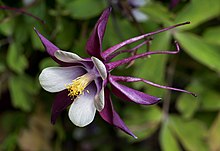Key innovation
The term was first used in 1949 by Alden H. Miller who defined it as "key adjustments in the morphological and physiological mechanism which are essential to the origin of new major groups",[1] although a broader, contemporary definition holds that "a key innovation is an evolutionary change in individual traits that is causally linked to an increased diversification rate in the resulting clade".
[2] Latex and resin canals in plants are used to deter predators by releasing a sticky secretion when punctured which can immobilise insects and some contain toxic or foul tasting substances.
The evolution of the hypocone and flat molars later allowed animals to adapt to a herbivorous diet as they could be used to break down tough plant matter through grinding.
Specialising for a plant based diet offered early herbivores sufficient resources to radiate as energy was not lost to higher trophic levels and few competitors existed at the time.
In addition the shape and size of the nectar spur can evolve in response to pollinator adaptations, developing a co-evolutionary relationship.

